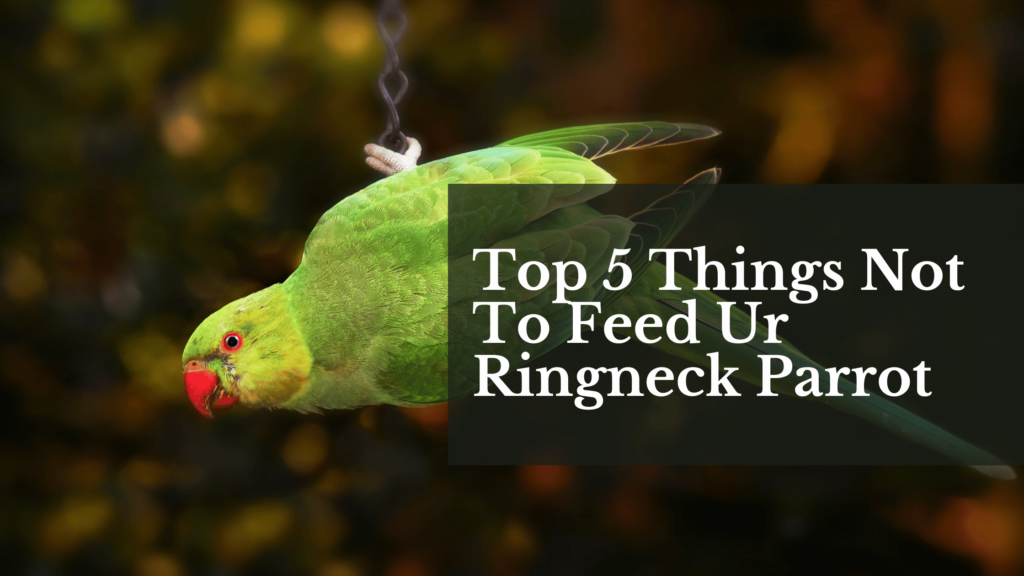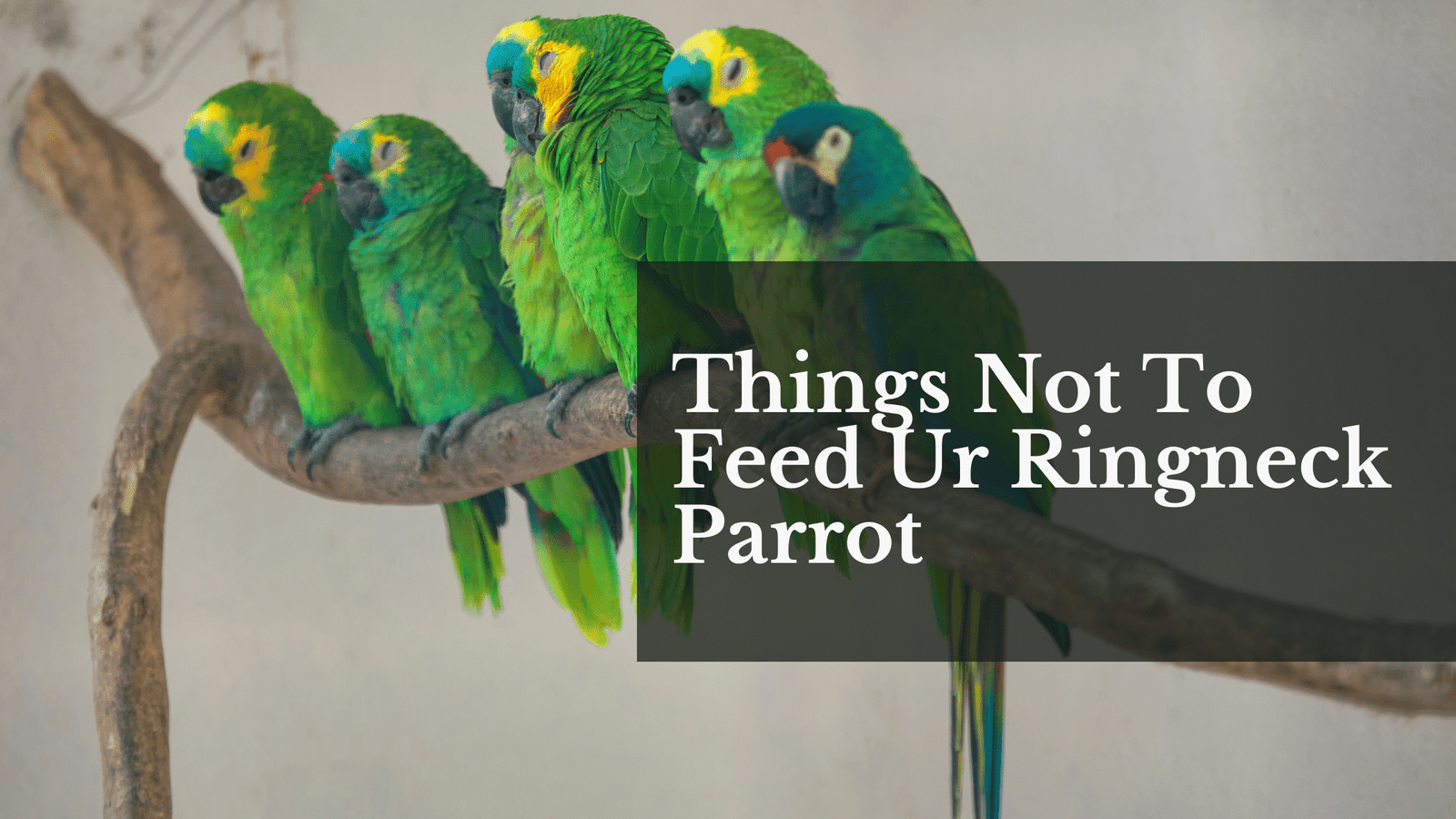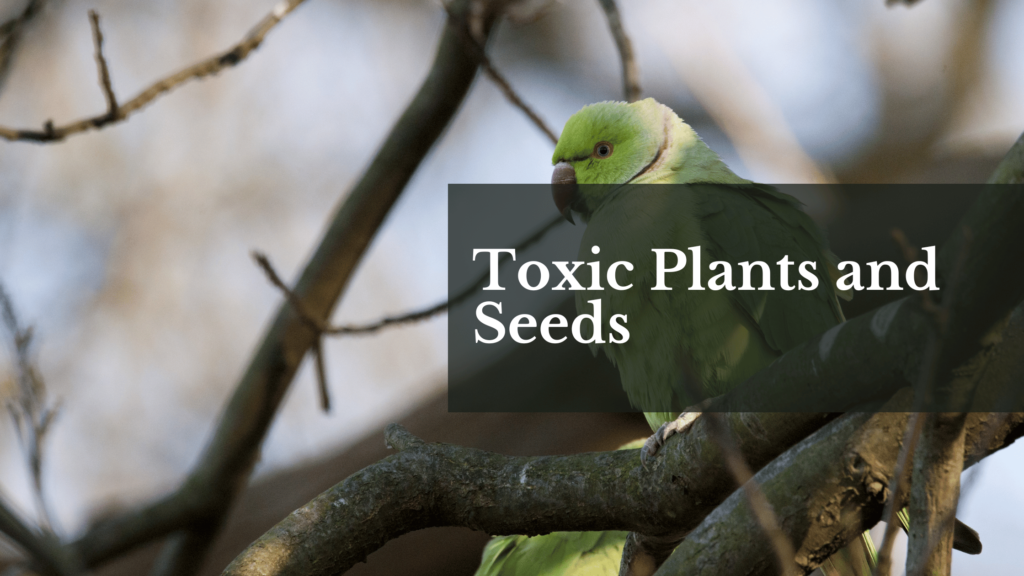Having athings not to feed ur ringneck parrot could be a very restorative process. These colorful and clever birds are great in that they bring happiness and entertainment to their owners by engaging them with their fun playfulness and kind-heartedness. Moreover, ringneck parrots, just like other pets, have certain nutritional requirements that should be met. These must be fulfilled to allow them to live a healthy and comfortable life.
A balanced diet is a key factor for the entire well-being of ringneck parrots. In this place, they are provided with many food options suitable for their health and to give them everything they need to become healthy and grow. Although you might be excited about the prospect of feeding your little fluffy friend to do them a favor, do not hastily suppose that foods safe for human consumption should also be good for birds to eat. Some specific species of parrots, including parrots of the ringneck family, exhibit an ability to be poisoned or even allergic when given some foods that constitute the usual human diet.
This article will discuss the top pet 5 things not to feed your ring-necked parrot. It can be from simple snacks to mundane pantry ingredients – these familiar types of food can actually be the ones that risk the health of your bird the most. By recognizing various sources of dangerous food for your parrot, you can keep your feathered ‘family’ healthy, happy, and long-lived.
Top 5 Things Not To Feed Ur Ringneck Parrot

1. Chocolate: A Sweet Treat to Avoid
Chocolate is everyone’s favourite, the thing that makes humans happy, but it’s not meant for parrots, it’s too dangerous for them, and they can easily get poisoned. This very tasty candy involves theobromine, a chemical that is poisonous to avians and can ultimately lead to severe health problems. Ringneck parrot’s system starts reacting after eating a small or not even the smallest amount of chocolate. Generally, symptoms might be vomiting, diarrhea, shakes, or seizures accompanied by short breaths or unconsciousness.
2. Avocado: More Than Just Guacamole
Avocado is a highly appreciated and recruited fruit by humans but can be a deadly poison for ringneck parrots. That explains this phenomenon as some avocados contain persin, which in quantities high enough can cause respiratory difficulties, heart failure, or even death in birds if ingested. Conversely, the avocado flesh is the most dangerous fraction compared to the skin and pit where the ladybird beetles live; they contain hazardous levels for the person.
It is critical that your ringneck parrot is protected from avocado pits. Therefore, it is prohibited to feed him any part of the pit. Further, be aware that any trays or snacks have Avocado as their ingredients, e.g., guacamole and avocado toast, and place them at a height the birds can’t access.
3. Alcohol: Not for Feathered Friends
Alcohol is another compound that parrots of the ringneck kind should not be given. The presence of species such as birds can also cause intoxication or impairments through alcohol abuse, thus resulting in accidents and injuries. Even so, the impact of this can definitely be very high among the birds – organs, or respiratory failure and loss of life may occur.
For your parrot, it is vital to place all alcoholic drinks out of reach of them and not use them as a drink or treat idea for them. Besides, even a small amount of alcohol can have devastating outcomes for your birdie; therefore, choose to be on the safer side and avoid exposure of your bird to this substance till death.
4. Caffeine: A Stimulant to Steer Clear Of
Caffeine is a medication that causes your body’s functions to behave actively. It can be found in coffee or tea, energy drinks, and chocolate. The unknown consequence of the addition of many men’s tastes for caffeine’s kick could take away the ability of many of the Jonquil parrots to survive. Birds contest the idea of being more caffeine-sensitive than human bodies. They may succumb to extreme health hazards or even die from feeding on their small amounts.
Ringneck parrots can be affected in this manner with caffeine poisoning symptoms, which manifest in their anxiety, rapid heartbeats, tremors, and difficulty breathing. Taking on caffeine in higher amounts in severe cases can provoke seizures, cardiac arrest, and death. It’s essential to not share your beverages or snacks with them that are caffeinated and also avoid keeping them secure at the place of reach.
5. Salty Snacks: Too Much Sodium Spells Trouble
Salty snacks, including potato chips, pretzels, and popcorn, play a great role in human taste buds, but as far as ringneck parrots are concerned, they should not be given. They have more salt than most food, which affects birds’ health since birds are consumed excessively. Feeding salt more than required affects the homeostasis in ringneck parrots by inducing dehydration, electrolyte imbalance, and kidney problems, negatively impacting their health and well-being.
Do not offer your bird-salted snacks. Instead, provide it with healthier options such as unsalted nuts, fresh fruits, and vegetables. This choice offers good nutritional value without the cons of over-sodium intake, which in return keeps your parrot safe all the time.
Household Hazards and Non-Food Items

1. Toxic Chemicals: Keep Them Locked Away
Most products used for household control and other chemicals have poisons, which can be hazardous or even deadly for the ring-neck parrots if ingested or inhaled by them. Ensure all dangerous chemicals that can harm your bird are securely stored in locked cabinets or a dedicated safety box that no one except yourself can access. When working with these products, strictly observe that your bird is safely away from the affected area and that any fumes and dust residues are properly ventilated.
2. Small Objects: A Choking Hazard
Ringneck parrots, as their nature is curious, may nibble at small objects and, by chewing or drinking, may even get them into their systems. On the other hand, swallowing small objects could lead to choking or even intestinal blockages in birds. It is another reason why bird feeders come in plastic advances which are slippery, therefore, prevent unintentional swallowing of the pellets even when the bird’s beak is pulled open. Put away items like buttons, beads, coins, and bands hidden from the reach of the birds. Also, you need to pay attention to any other toy or thing that contains parts that could be swallowed accidentally.
3. Electrical Cords: Prevent Electrocution
Small electrical cords and wiring can attract cats, but they pose a high risk of electric shock if they bite into or chew through. To reduce the possibility of mishaps, bind or coil electrical cords and wires, and hide them from your bird’s reach using cord covers, cable organizers, or running them behind furniture. Similarly, consider giving your bird shreddable toys or untreated wooden blocks to fulfill their instinct to chew, and ensure safety.
4. Toxic Fumes: Ensure Proper Ventilation
Consequently, birds are susceptible to poisonous fumes from the smoke of cigarettes, sprayers, and household cleaners. This can damage their respiratory systems. Providing good air circulation by opening windows or using a fan is the best way to take some of the stagnant air at home. Do not smoke in the house, and choose cleaners that do not contain any toxic substances. If you have to use aerosol sprays or other possibly toxic substances, consider removing your bird from the environment until all the residues of these substances have vanished.
5. Plastic and Rubber: Watch Out for Swallowing
Fragments of plastic or rubber can constitute a danger, like plastic 3d models, bottles, or common household items, swallowed by a ringneck parrot. This organic matter can obstruct the gut and lead to insoluble blockage or impactions that have serious health consequences. It is Fraudulent to provide your bird with plastic or rubber toys. Therefore, the safest option is to give them wooden, paper, or leather toys instead. Furthermore, be careful of all potential plastic or rubber things in the house where the bird can get them and ban them from your bird’s reach.
Conclusion
Finally, one should consider additional factors such as food and shelter to raise a ringneck parrot. If you know about foods that could be toxic, such as chocolate and avocado, you should avoid giving these to your bird. Besides, you need to be careful with poisonous plants, such as oleander, and household items containing electric cords or toxic chemicals. You’ll be able to create a nice and healthy environment because of this. Furthermore, taking care of small stuff and making sure that they have alternative objects for chewing helps with physical safety. Immense pleasure bonds emerge from your parrot by prioritizing its health and safety. Therefore, the relationship can be full for years.
FAQs: Things Not to Feed ur, Ringneck Parrot,
What can I feed my ringneck parrot?
You can provide a good variety for a ringneck parrot, including fresh fruits and vegetables, pellets (of high quality), nuts, seeds (presently in smaller quantities), and occasional treats like grains (cooked) and lean meat. It is vital for us to ensure that we offer a mix so that their nutritional requirements are met.
Can Indian ringnecks eat yogurt?
Yes, parrots belonging to the Indian ringneck species can ingest plain, sour yogurt in minimal quantities, only while enjoying the occasional treats. On the other hand, dairy products (including milk) should not constitute significant portions of a parrot’s diet, given their lactose intolerance which might otherwise cause digestive troubles.
What is a parrot’s favorite food?
Parrots are creatures of habituate, but the fact remains that many of them enjoy fruits like apples and grapes, or bananas and vegetables like carrots, broccoli, and leafy greens. Along with reg regs and nutlets, seeds and some grains are adored by other species.
Do parrots eat a lot?
Certain species of parrots exhibit very high metabolism and can take in large amounts of food relative to the smaller size of the bird. Nevertheless, the portion will be manageable for a small/young/less active parrot. It’s great to monitor the food intake and adjust portions appropriately to sustain the normal weight point.
What parrot eats the most?
Not any particular parrot species is the solution to this riddle as dietary preferences change from one individual to another, as well as species variants. Besides, larger parrot species, like macaws and cockatoos, might eat more than smaller ones because of their size and power input. It’s effective in offering a dietary balance that is adapted to each parrot species’ particular conditions.

